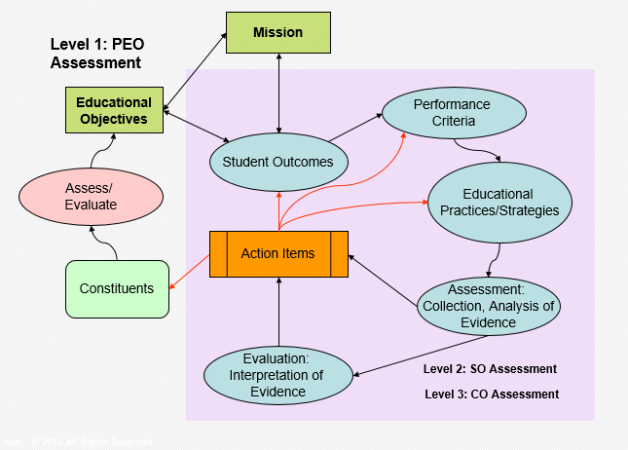Basic of Outcome Assessment

Basic Concept of Outcomes Assessment
Outcomes assessment is a process which gauges a program's educational quality and provides for continual teaching and learning improvement. The focus is on providing a meaningful and relevant student learning experience. The process is generally correlated to an institutional mission.
Let's say your program intends to engage in a meaningful, outcomes-based educational practice. The goal is to improve the teaching and learning experience, which ensures a high-quality educational program. The best practices of assessment for your program are needed. The assessment flow cycle presented here is a good starting point regardless of the type of your program. The flow cycle above was adopted from Gloria Rogers' work and has been modified to suit our needs. For more of Gloria Rogers' excellent ideas and work in assessment, please visit www.abet.org. For consistent discussion, we adopt the same terminologies used by ABET for outcomes assessment.
Level 1: PEO Assessment:
Here the program educational objectives are the statements that describe the expected accomplishments of graduates during the first few years after graduation. The student outcomes are statements that describe what students are expected to know and be able to do by the time of graduation. The key distinction between the PEO and the SO is the time frame in which student performance is measured. From the program perspective, the SO is what can be measured and should be used as a guide to steer students towards the PEO after graduation. So most program assessment centers on meeting the SO, not the PEO. After the SO is properly measured and assessed, the action items generated should then be used to further assess if the PEOs are really being achieved. As indicated in the flow cycle, this level of assessment is termed Level 1: PEO assessment. Since the PEO looks at a time frame three or four years after a student graduates, the assessment cycle for Level 1 is expected to be conducted once every three to five years. This cycle is sufficient to gauge the PEO relevancy to the needs of the program's constituents. Since action items are the result of outcomes assessment, which involves a different cycle of assessment, it is clear that the outcomes assessment for addressing the PEOs is eventually met.
Level 2: Student Outcomes (SO) Assessment Cycle:
Performance Criteria:
To assess student outcomes meaningfully, we must have performance criteria to guide us. Performance Criteria are specific measureable statements identifying the performances required to meet the outcome with confirmable, thorough evidence. Once performance criteria have been defined, the methodologies and direct or indirect approaches used in assessment vary from program to program and also implementation strategies.
Educational Practices:
Educational practices and strategies may mean how you would implement various combinations of assessment methods listed above, and the frequency and interval of those assessment methods. Here is where most of people differ about good practices or excessive/overly burdensome process of assessment. How often should we collect and evaluate results? Who should be involved and responsible for the process? Should each outcome be assessed every year? How much objective evidence is considered sufficient? How many courses should be used to gauge the success level in meeting a specific student outcome? Should we use embedded course assessment? Once you answer these and other questions, you will arrive at an educational practice that may work for you. The next question is "Assessment."
Assessment:
Assessment is the processes that identify, collect, analyze, and report data that can be used to evaluate achievement. In this case, achievement is the student outcomes or course outcomes. Assessment is generally a time-consuming data collection process and an analysis of evidence for meaningful evaluation, the next logical step.
Evaluation:
Evaluation is a process of reviewing the results of data collection and analysis and making a determination of the value of findings and actions to be taken. In view of this definition of evaluation, evaluation is a critical step to ensure the quality improvement process. Without proper evaluation, the assessment of data collection is rendered meaningless and eventually leads to failure and frustration for the parties involved.
Action Items:
With evaluation comes action items. Perhaps the most meaningful step in the overall flow cycle of assessment is the action items that allow closing the loop for real quality assurance. With action items as the feedback loop to change or improve student outcomes, performance criteria, and educational practices, the cycle of outcomes assessment is repetitive or a work-in-progress. This form the Level 2: SO Assessment.
Level 3: Course Outcomes (CO) Assessment:
If the educational practices in Level 2 SO Assessment use embedded course assessment, then this gives rise to Level 3: CO Assessment. That is, outcomes of core courses in the curriculum are being assessed to see if student learning meets the course outcomes. Course outcomes assessment involves the same cycle of assessment as student outcomes. That is, performance criteria for outcomes have to be defined, the assessment process of collecting and analysis of evidence is conducted, and the evaluation process of interpretation of evidence needs to be performed, which eventually leads to action items for improvement at a course level. This level of assessment is the most time consuming and rewarding.
In conclusion, the overall assessment cycle consists of three levels of interacting assessment cycles: (1) the PEO assessment (3-5 year time frame); (2) the SO Assessment (1-3 year time frame); and (3) the CO Assessment (every term). These three levels of the assessment cycle needs different toolsets since their assessment time frames are different. To find out more, please read Three Levels of Assessment.
Don't Miss Any Opportunity
Contact us anytime.

Keep In Touch
